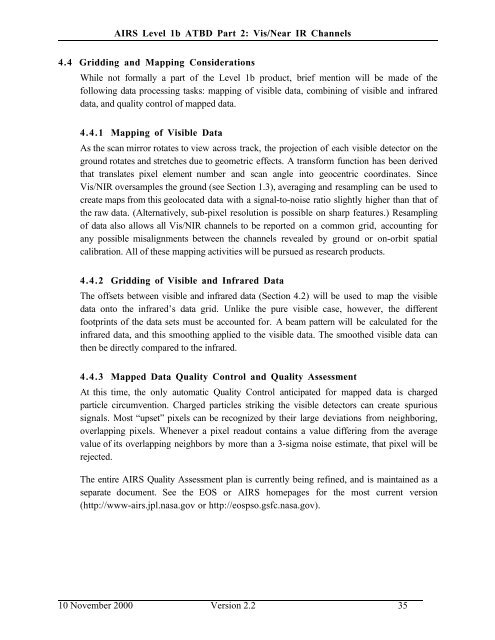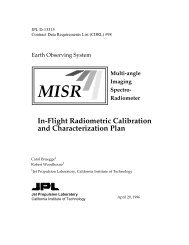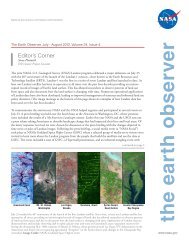AIRS Level 1B Visible/Near-Infrared Channels ATBD - NASA's Earth ...
AIRS Level 1B Visible/Near-Infrared Channels ATBD - NASA's Earth ...
AIRS Level 1B Visible/Near-Infrared Channels ATBD - NASA's Earth ...
Create successful ePaper yourself
Turn your PDF publications into a flip-book with our unique Google optimized e-Paper software.
<strong>AIRS</strong> <strong>Level</strong> 1b <strong>ATBD</strong> Part 2: Vis/<strong>Near</strong> IR <strong>Channels</strong><br />
4.4 Gridding and Mapping Considerations<br />
While not formally a part of the <strong>Level</strong> 1b product, brief mention will be made of the<br />
following data processing tasks: mapping of visible data, combining of visible and infrared<br />
data, and quality control of mapped data.<br />
4.4.1 Mapping of <strong>Visible</strong> Data<br />
As the scan mirror rotates to view across track, the projection of each visible detector on the<br />
ground rotates and stretches due to geometric effects. A transform function has been derived<br />
that translates pixel element number and scan angle into geocentric coordinates. Since<br />
Vis/NIR oversamples the ground (see Section 1.3), averaging and resampling can be used to<br />
create maps from this geolocated data with a signal-to-noise ratio slightly higher than that of<br />
the raw data. (Alternatively, sub-pixel resolution is possible on sharp features.) Resampling<br />
of data also allows all Vis/NIR channels to be reported on a common grid, accounting for<br />
any possible misalignments between the channels revealed by ground or on-orbit spatial<br />
calibration. All of these mapping activities will be pursued as research products.<br />
4.4.2 Gridding of <strong>Visible</strong> and <strong>Infrared</strong> Data<br />
The offsets between visible and infrared data (Section 4.2) will be used to map the visible<br />
data onto the infrared’s data grid. Unlike the pure visible case, however, the different<br />
footprints of the data sets must be accounted for. A beam pattern will be calculated for the<br />
infrared data, and this smoothing applied to the visible data. The smoothed visible data can<br />
then be directly compared to the infrared.<br />
4.4.3 Mapped Data Quality Control and Quality Assessment<br />
At this time, the only automatic Quality Control anticipated for mapped data is charged<br />
particle circumvention. Charged particles striking the visible detectors can create spurious<br />
signals. Most “upset” pixels can be recognized by their large deviations from neighboring,<br />
overlapping pixels. Whenever a pixel readout contains a value differing from the average<br />
value of its overlapping neighbors by more than a 3-sigma noise estimate, that pixel will be<br />
rejected.<br />
The entire <strong>AIRS</strong> Quality Assessment plan is currently being refined, and is maintained as a<br />
separate document. See the EOS or <strong>AIRS</strong> homepages for the most current version<br />
(http://www-airs.jpl.nasa.gov or http://eospso.gsfc.nasa.gov).<br />
10 November 2000 Version 2.2 35







